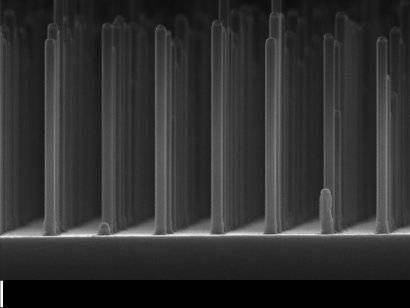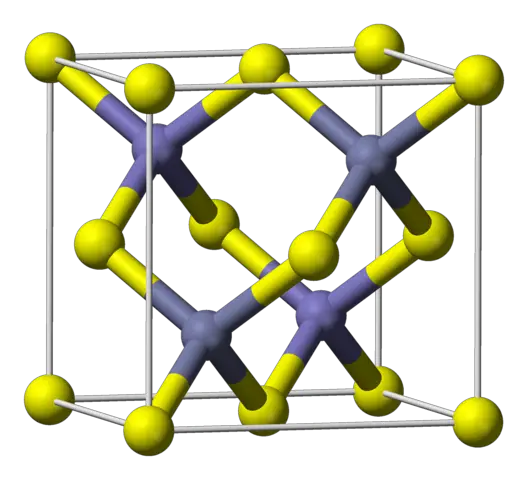ScienceRocks
Democrat all the way!
- Banned
- #1
Nanowires boost solar fuel cell efficiency tenfold
Nanowires have been used by Dutch researchers to boost solar fuel cell efficiency tenfold, while using 10,000 times less precious material.

Researchers at Eindhoven University of Technology (EUT) and the Foundation for Fundamental Research on Matter (FOM) in the Netherlands have demonstrated a highly promising prototype of a solar cell that generates fuel, rather than electricity. The material gallium phosphide enables their cell to produce the clean fuel hydrogen gas from liquid water. By processing the gallium phosphide using tiny nanowires, the yield is boosted by a factor of ten, while using 10,000 times less precious material.
Electricity produced by a solar cell can be used to set off chemical reactions. If this generates a fuel, then one speaks of solar fuels – a hugely promising replacement for polluting fuels. One possibility is to split liquid water using the electricity that is generated (electrolysis). Among oxygen, this produces hydrogen gas that can be used as a clean fuel in the chemical industry or combusted in fuel cells – in cars for example – to drive engines.
To connect an existing silicon solar cell to a battery that splits the water may well be an efficient solution now, but is very expensive. Many researchers are therefore trying to develop a semiconductor material able to both convert sunlight to an electrical charge and split the water, all in one; a kind of "solar fuel cell". Researchers at EUT and FOM see their dream candidate in gallium phosphide (GaP), a compound of gallium and phosphorus that also serves as the basis for specific coloured LEDs.

GaP has good electrical properties, but it cannot easily absorb light when it consists of a large flat surface, as used for solar cells. The researchers overcame this problem by making a grid of tiny GaP nanowires, measuring 500 nanometres (a millionth of a millimetre) in length and just 90 nanometres thick. This design immediately boosted the yield of hydrogen to 2.9 percent – a factor of ten improvement and a record for GaP cells, even though still some way off the 15 percent achieved by silicon cells coupled to a battery.
Research leader and EUT professor Erik Bakkers said it’s not simply about the yield – where there is still a lot of scope for improvement he points out: “For the nanowires we needed 10,000 less precious GaP material than in cells with a flat surface. That makes these kinds of cells potentially a great deal cheaper. In addition, GaP is also able to extract oxygen from the water – so you then actually have a fuel cell in which you can temporarily store your solar energy. In short, for a solar fuels future we cannot ignore gallium phosphide any longer.”
The researchers describe their breakthrough in the journal Nature Communications.
way cool
Nanowires have been used by Dutch researchers to boost solar fuel cell efficiency tenfold, while using 10,000 times less precious material.

Researchers at Eindhoven University of Technology (EUT) and the Foundation for Fundamental Research on Matter (FOM) in the Netherlands have demonstrated a highly promising prototype of a solar cell that generates fuel, rather than electricity. The material gallium phosphide enables their cell to produce the clean fuel hydrogen gas from liquid water. By processing the gallium phosphide using tiny nanowires, the yield is boosted by a factor of ten, while using 10,000 times less precious material.
Electricity produced by a solar cell can be used to set off chemical reactions. If this generates a fuel, then one speaks of solar fuels – a hugely promising replacement for polluting fuels. One possibility is to split liquid water using the electricity that is generated (electrolysis). Among oxygen, this produces hydrogen gas that can be used as a clean fuel in the chemical industry or combusted in fuel cells – in cars for example – to drive engines.
To connect an existing silicon solar cell to a battery that splits the water may well be an efficient solution now, but is very expensive. Many researchers are therefore trying to develop a semiconductor material able to both convert sunlight to an electrical charge and split the water, all in one; a kind of "solar fuel cell". Researchers at EUT and FOM see their dream candidate in gallium phosphide (GaP), a compound of gallium and phosphorus that also serves as the basis for specific coloured LEDs.

GaP has good electrical properties, but it cannot easily absorb light when it consists of a large flat surface, as used for solar cells. The researchers overcame this problem by making a grid of tiny GaP nanowires, measuring 500 nanometres (a millionth of a millimetre) in length and just 90 nanometres thick. This design immediately boosted the yield of hydrogen to 2.9 percent – a factor of ten improvement and a record for GaP cells, even though still some way off the 15 percent achieved by silicon cells coupled to a battery.
Research leader and EUT professor Erik Bakkers said it’s not simply about the yield – where there is still a lot of scope for improvement he points out: “For the nanowires we needed 10,000 less precious GaP material than in cells with a flat surface. That makes these kinds of cells potentially a great deal cheaper. In addition, GaP is also able to extract oxygen from the water – so you then actually have a fuel cell in which you can temporarily store your solar energy. In short, for a solar fuels future we cannot ignore gallium phosphide any longer.”
The researchers describe their breakthrough in the journal Nature Communications.
way cool

